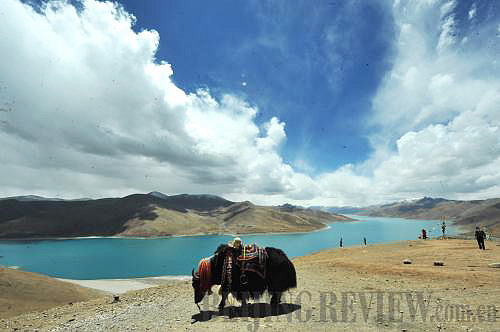
A lake at the foot of the Himalaya Mountains (XINHUA)
My first visit to China was in 1986. After that I have been to this charming country several times and during these visits heard interesting stories about Tibet—the land of intriguing contrasts—around which countless yarns of fact and fiction have been spun. However, for one reason or the other, I could not visit Tibet.
Though keen to avail myself of the earliest possible opportunity to visit Tibet I was a bit reluctant, and rather nervous, to go there because of my advanced age, especially when I heard the horrid stories about altitude sickness, leading to plateau pneumonic edema which could result in death. I jokingly told my hosts that I did not want to be a sacrificial lamb to be offered at the altar in Lhasa. However, when my hosts assured me that I would be provided with foolproof protection in Tibet I tamely surrendered and agreed to go.
After flying from Beijing to Xining, the capital of Qinghai Province, and then boarding a train for Lhasa, which weaved its way through a stunning landscape of the Qinghai-Tibet Plateau, I finally arrived in Tibet.
Lhasa, capital of Tibet, is a city of elegant and impressive public buildings beautifully intertwined with green spaces. In Tibetan language, Lhasa means holy. No doubt, it is a holy city, as it is home to two of the most venerated shrines in Tibet—the Potala Palace and the Jokhang Temple.
Perched on the top of the Red Hill, Potala was built in the seventh century and is a huge structure of 909 rooms with a big central courtyard. Priceless antiques and artifacts adorn each and every corner of the palace evoking nostalgia for the opulent lifestyles of the royal clans. From atop one has a panoramic view of the beautiful city sprawled below.
Not far from the Potala Palace is the Jokhang Temple, which is considered one of the most revered temples in the region where people from all over Tibet and other places come to seek the blessings of Buddha. Jokhang symbolizes the unique spiritual heritage of Tibet. Our guide told us that because of its big historical and religious significance the Central Government of China is taking special care of the temple's maintenance. Built by the Tubo King Songtsan Gampo in 647, the Jokhang Temple had a life-size statue of Sakyamuni, or the Buddha, Songtsan Gampo and his wife, Princess Wencheng.
Life in Lhasa is quite fast-paced and the city has all the comforts and luxuries of a metropolis, like star rated hotels, top-notch restaurants, fashionable shopping malls stocking the latest brands from China and across the globe. However, in spite of its meteoric evolution, Lhasa is still keeping intact its old world charm and character.
